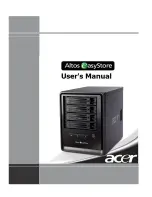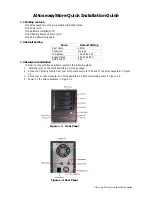
Viewing logical VolumeCopy Properties
Use the
show VolumeCopy
command to view information about one or more selected source logical drives
or target logical drives. This command returns these values:
v
The role
v
The copy status
v
The start time stamp
v
The completion time stamp
v
The copy priority
v
The Read-Only attribute setting for the target logical drive
v
The source logical drive World-Wide Identifier (WWID) or the target logical drive WWID
If a logical drive is participating in more than one VolumeCopy (it can be a source logical drive for one
VolumeCopy operation and a target logical drive for another VolumeCopy operation), the details are
repeated for each associated copy pair.
The command takes this form:
show VolumeCopy (allLogicalDrives | source [
sourceName
] |
target [
targetName
])
This example shows the
show VolumeCopy
command:
c:\...\...\client>smcli 123.45.67.89 -c “show VolumeCopy source [\”JabaHut\”];”
The command in this example is requesting information about the source logical drive JabaHut. If you
wanted information about all of the logical drives, you would use the
allLogicalDrives
parameter. You
can also request information about a specific target logical drive.
This example shows how to use the command in a script file:
show VolumeCopy source [“JabaHut”];
Changing logical VolumeCopy Settings
The
set VolumeCopy
command lets you change these property settings for a VolumeCopy pair:
v
The copy priority
v
The target logical drive read/write permission
Copy priority has five relative settings ranging from highest to lowest. The highest priority supports the
VolumeCopy, but I/O activity might be affected. The lowest priority supports I/O activity, but the
VolumeCopy takes longer. You can change the copy priority at these times:
v
Before the VolumeCopy operation starts
v
While the VolumeCopy operation has a status of In Progress
v
After the logical VolumeCopy operation has completed when re-creating a VolumeCopy operation by
using the
recopy VolumeCopy
command
When you create a VolumeCopy pair and after the original VolumeCopy has completed, the target logical
drive is automatically defined as read-only to the hosts. The read-only status of the target logical drive
helps to make sure that the copied data on the target logical drive is not corrupted by additional writes
to the target logical drive after the VolumeCopy is created. You want to maintain the read-only status
when you are performing these tasks:
v
Using the target logical drive for backup purposes
v
Copying data from one subsystem to a larger subsystem for greater accessibility
9-6
IBM System Storage DS3000, DS4000, and DS5000: Command Line Interface and Script Commands Programming Guide
Summary of Contents for System Storage DS3000
Page 599: ...Appendix A Examples of information returned by the show commands A 3...
Page 601: ...Appendix A Examples of information returned by the show commands A 5...
Page 603: ...Appendix A Examples of information returned by the show commands A 7...
Page 605: ...Appendix A Examples of information returned by the show commands A 9...
Page 607: ...Appendix A Examples of information returned by the show commands A 11...
Page 609: ...Appendix A Examples of information returned by the show commands A 13...
Page 611: ...Appendix A Examples of information returned by the show commands A 15...
Page 623: ...Appendix A Examples of information returned by the show commands A 27...
Page 625: ...Appendix A Examples of information returned by the show commands A 29...
Page 627: ...Appendix A Examples of information returned by the show commands A 31...
Page 651: ......
Page 652: ...Part Number 00W1466 Printed in USA GA32 0961 05 1P P N 00W1466...
















































